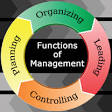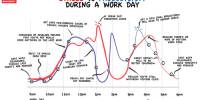Any organization, whether new or old, small or big, requires certain methods, procedures and plans in place for its efficient functioning. For this to happen, they must develop and implement management concepts which help them implement their vision for the future of the organization.
Index
➤ Planning
➤ Organizing
➤ Directing/Leading
➤ Controlling
➤ Staffing – The Fifth Function
The four concepts of management, translated into functions lead to the creation of a cohesive organization. They can be shown here as a diagram. It is interesting to note that there is no hard and fast rule to be followed in the application of these functions, as management is a real-time decision-making system, any of these functions can be operational in conjunction with any other and also as independent entities themselves.
Four Functions
Planning
Planning is the foundation pillar of management. It is the base upon which the all other areas of management are built. Planning requires administration to assess where the company presently is and where it would be in the upcoming years. From there, an appropriate course of action is determined and implemented to attain the company’s goals and objectives.
Planning is an unending course of action. There may be sudden strategies, required to be implemented during a crisis. There are external factors that constantly affect a company, both positively and negatively. Depending on the conditions, a company may have to alter its course of action regarding certain goals. This kind of preparation or arrangement is known as strategic planning.
In strategic planning, management analyzes internal and external factors, that may affect the company, its objectives and goals. One of the primary tools of strategic planning is the use of SWOT Analysis, a technique that helps organizations find their strengths and weaknesses, identify areas of opportunity and take preventive measures against threats arising from both internal and external environmental factors.
The SWOT matrix can be understood by dividing it’s cells according to what they represent for the organization.
Internal environment stands for the factors affecting performance within the company itself, this could be both positive or negative in nature.
External environment is the outside world, factors beyond the control of the organization which may affect it in positive or negative ways.
Strengths are the things that the organization does well, its core competency in production, sales, innovation and so on.
Weaknesses are the areas which need improvement such as a high attrition rate.
Threats are the foreign variables that affect the company such as government regulations, entry of new competitors or even natural disasters.
An organization can analyze it’s position in relation to its strengths and weaknessess by classifying them in the SWOT matrix. Then the planning process can incorporate the results and solutions offered in its structure, along with the necessary strategy changes required.
Swot Analysis
How Does Planning Happen?
Although in theory, planning may sound like a static one-off activity which is to be done in a particular manner and then left to fend for itself, it is a dynamic process which can be broken up into different parts for ease of understanding and also as a reference. It progresses through stages of development and is ultimately, like most management principles, a looping function, without review and monitoring it will not be effective.
➤ Setting Objective Goals
Before the actual process of planning can begin, one must know what its purpose is, where is all this discussion and debate going to lead?
An objective marker, as a desirable and rational outcome of planning should be first outlined.
This objective must be precise before it is anything else. Saying that we plan to achieve a certain figure of sales and make a certain amount of profit is nonsensical, when the means to achieve them have not been decided upon.
Planning objectives must be realistic, enthusiasm about a particular sector of the economy, or a new launch having performed well in the initial months, can lead to unrealistic and often unachievable goals being set by the managers.
How can objectives be realistic? The best way is to state them in numbers, with clear language and a frame of reference which all employees can understand. For example, an objective of producing 20,000 units by the 30th of March with a reduction in operating expenses by 3% and launching X product in 3 (names) markets simultaneously on (date), is much more to the point than saying we will increase production, lower costs and make a huge profit selling our new product this year.
However, not all goals and their objectives can be set down in quantitative terms, some are subjective and can only be described or formulated according to precedent. An example is the effect of motivational programs on the efficiency of the employees.
➤ Developing Planning Premises
A premise is an assumption about something that has not yet come to pass. In relation to planning, these premises take the nature of analytical forecasts which are made to understand future conditions. Care must be taken that the forecast data be in quantitative terms and not a qualitative or descriptive view. Data makes it easier to forecast future revenue streams and possible holdups due to working capital issues. On the outside it can give a feeling of how the economy and competitors might behave in the future.
➤ Recognizing Limitations
An organization is a coming together of different people who work in different verticals, although for the primary purpose of achieving a set goal. This may not, however, be as easy to do in the real world, there may be several limitations to the organization’s smooth functioning due to bottlenecks in different departments like the human resources, operations and finance. A good plan must incorporate these limitations into its structure, to be able to deal with them when the time comes.
➤ Plan Period
A suitable time frame is necessary to be able to achieve the objectives in a systematic fashion. A plan period sets apart a number of days or months, depending upon the nature of the plan, after accounting for the objectives, premises and limitations it might be subject to. This time frame is an objective in itself and acts as a guideline for fulfillment of the various aspects of the plan. Care must be taken to ensure that the plan period is reasonable and not over-enthusiastic or pessimistic about the objectives.
➤ Formulating Strategies and Policies
The basic function of any plan is to lay down certain policies and adopt strategies which will propel the organization toward its goals. The top management of the organization, in consultation with the subordinates, must outline these strategies. Policies can be of various kinds such as new audit norms for the finance department or changes in hiring practices for the HR department. Strategies are broader in their scope and are more focused on short term or long term results. Alternative strategies and plans must also be formulated as fall-backs, in case changes are required during the plan period.
➤ Operational Planning
Support plans are required for the broader strategies and policies developed by the management. These policies are mostly short term in nature and are done more on the departmental level, they are usually implemented to improve efficiency in the various procedures.
➤ Review and Appraisal of Plans
Once the various plans are in action, there must be timely reviews to judge whether they are operating according to the given objectives. A plan may look attractive on the boardroom table but may not necessarily work on the assembly line or integrate with the supply chain of the organization. A review is therefore another primary aspect of the planning process, any changes that are required must be documented and embedded in the next iteration of the plans.
Back to Index
Organizing
The second function of the management is getting prepared and getting organized. The management must organize all its resources beforehand, to follow the course of action decided during the planning process. While determining the hierarchy of the organization, managers must look at the requirements of different divisions or departments. They must also ensure the harmonization of staff, and try to find out the best way to handle the important tasks and reduce unnecessary expenditure within the company. Management determines the division of work according to its need. It also has to decide for suitable departments to hand over authority and responsibilities.
The following can be steps in organizing function from the perspective of a manager.
➤ Defining Jobs and Activities
Job profiles need to be identified according to the needs of the various departments within a company. The accounts department will need a cashier, just as the assembly line will require the services of supervisors and workers, both skilled and unskilled. Even before this is done, the activities themselves must be clear, accounting of pay-in slips or the steps involved in the production, all this must be ready at hand for the managers to refer to and accordingly make appointments.
➤ Organizing Activities
The second step is to organize these varied jobs into manageable units. A good example is classifying the workers in charge of welding under a separate supervisor, or setting up a team of software engineers under a team leader. This aspect of organizing deals with the division of labor in the organization.
➤ Distribution of Authority
The next step is to specify the range and breadth of the powers given to various managers and supervisors working in different departments. This is necessary for the division of responsibility and effective reporting.
➤ Balancing Authority and Responsibility
Only classifying and assigning responsibility is not enough, a manager must make sure the different departments co-ordinate among themselves and recognize the powers and duties assigned to each one of them. This is vital as the smooth functioning of the whole organizational structure depends upon people learning to work together.
Back to Index
Directing/Leading
Directing/Leading
Directing or leading is the third function of management. Working under this function helps the management control and supervise the actions of the staff. It also enables them to render assistance to the employees by guiding them in the right direction, to achieve the company’s goals and also accomplish their personal or career goals, which can be powered by motivation, communication, department dynamics, and department leadership. Some characteristic features of the directing function are as follows.
Directing attempts to motivate and lead the employees toward the planned objectives. It is therefore inspirational in nature.
Directing aims to delegate tasks to subordinates, doing this the right way can be helpful in increasing the productivity of the entire organization.
Directing is undertaken by all levels of the management. A superior directs his subordinate who in turn delegates tasks to the people he supervises and so on. The worker on the shop floor also directs the machines to perform certain tasks.
Directing is a very human function of management in that it deals with people on a personal basis. Managers who have the responsibility to direct have to be sensitive to behavior patterns and have the ability to read body language so as to make more informed decisions regarding their employees.
Back to Index
Controlling
Control – the last of the five functions of management, includes establishing performance standards, which are aligned to the company’s objectives. It also involves evaluation and reporting of actual job performance. When these points are studied by the management, it is necessary to compare both these things. This study or comparison leads to further corrective and preventive actions. The controlling function aims to check if the tasks being allotted are performed on time and according to the standards set by the quality department.
Controlling happens after the planning process has been implemented and the tasks assigned. It aims to see if the results are in line with the objectives set forth in the original plan.
Standards must be set according to the resources available and accounting for external factors which may affect performance.
The controlling processes, in comparison with other three, is a continuous process. All levels of management take part in this function.
Control is also dynamic in nature as the management can anticipate future problems, adopt necessary preventive measures, and make policy changes in time.
Effective and efficient management leads to success, which is the attainment of objectives and goals, that an organization sets for itself. Of course, for achieving the ultimate goal, creative problem-solving and successful application of all five functions is necessary.
Back to Index
Staffing
Some modern management experts also include the function of staffing as an important management practice. Without human resources, no organization can get off the ground, let alone do business and make profits. Even the most labor efficient business models like online marketing and consulting require expertise in the form of knowledgeable individuals whose job it is to identify trends, do research and provide business plans or solutions to problems. In industries where man power is required for important processes of production such as manufacturing, mining, automobiles and heavy engineering, staffing can be a crucial aspect of the business. Some distinct features of staffing function are mentioned below.
Staffing is an important function because it puts the right man in the right job.
It is an ongoing activity as employees keep leaving and joining the company, they also retire from time to time leaving empty places in various positions.
Efficiency is a prime focus of this function as managing people is the toughest job there is, everything must be accounted for, leaves, payments, benefits, medical allowances, social security accounting and much more.
It is very important to maintain a productive working environment, build positive interpersonal relationships and engage in problem solving. This can only be done effectively, with proper communication. Understanding the communication process and working on areas that need improvement, helps managers become more effective planners.
















